Connected or Linked Speech
In this video, I will illustrate the term ‘linking’ which refers to the joining together of words. In order to have a smooth, connected delivery, it is necessary to emphasize certain aspects of the joining of words. For example, there is the tendency in naturally-spoken English to attach the final consonant of one word to the first syllable of the next, especially if the second word begins with a vowel. Listen to this example:
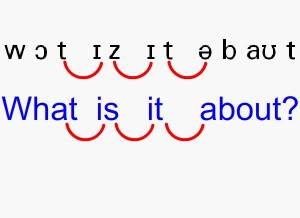
Reading slowly you can hear that the ‘t’ of ‘what’ is actually the beginning of the word ‘is’ and the final voiced ‘s’ of ‘is’ seems to be the beginning of the word ‘it’.
Native English speakers generally speak by linking words and almost never break the individual words apart unless they slow down. These spoken connections can be represented in phonetic transcriptions. So the first consideration of connected speech is the linking between words.
There are other occurrences of linking that happen in normal spoken English language. Sometimes when two words are joined together, we interpolate and extra sound. Look at the next example and listen:
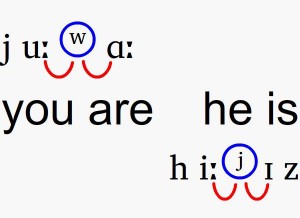
The sounds that are produced between the words are called semivowels or ‘glides’ and they are indicated in the phonetic transcription with a smaller letter that is slightly raised from the base line and extra spaces between the words. Note that the linking line, which indicates the sound to and from the glide, is placed directly before and after the smaller and slightly raised letter.
When the ending of one word blends into the sound of the beginning of the following word, assimilation takes place. In other words when certain words are joined together in natural speech, we add a new sound as a combination of the two original sounds. Final ‘t’s and ‘d’s when followed by words like ‘you’ or ‘your’ take on a different character or sound. Look at the next example:
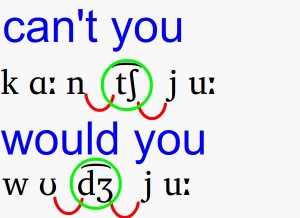
The next ‘linking’ sound that we will see is also a form of assimilation. It occurs in the presence of consonant sounds called ‘plosives’. This group includes the sounds of t, d, k, ɡ, b and p. In order to produce these sounds the mouth goes through three phases; firstly catching the air, holding the air causing pressure to build up, and releasing or exploding as the closure is opened. When two consecutive words end and begin with a similar ‘plosive’ consonant, the first consonant is not exploded but held for an instant. Sometimes the first sound actually is substituted for another. In cases like these, the first consonant is transcribed in brackets. For example:
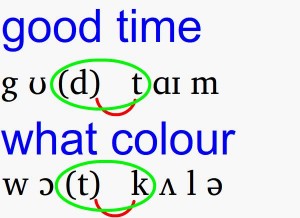
The last linking sound we will consider is actually the same as the previous assimilation. But in this case the consonants are long, like ‘l’, ‘s’ and ‘n’. So we can see them transcribed with a dash instead of brackets. The transcription occurs when the last sound of the first word and the first sound of the second word are the same. See the example:
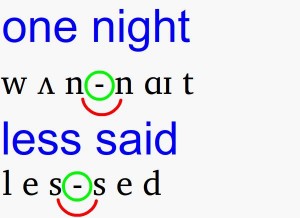
Of course there are many other examples of linked speech. For example, assimilation happens with words that end in ‘ng’ when followed with words that begin with a vowel. Sometimes, sounds disappear. Final ‘s’s, often disappear in normal speech when followed by an initial consonant of the same family like ‘s’ or sh’. There are considerations for the ‘r’ sound which can also be analysed. But the main linking sounds which may help you speak more naturally have been introduced.
I hope you have found this video helpful.
Hi anthony I very appreciated the video, very helpful.
soon
Ezio
Hi Antony,
Thank you for your sharing with so many helpful in this article.
I’m learning English and this is very very good for me. :D.
Wanna see more helpful article like this. :D.
Hello! I am from Slovakia, a small state in the central Europe. I am very, very grateful for what you did in this article. It is highly important for non speaker in english language. Please, one more time – Thank you very much! Have a nice day!
Very useful, I find the ideas in the video very easy to catch. I come from vietnam
Thank you very much for the video.
Hi Antony,
Thank you for your sharing with so many helpful in this article. I love the way you teach, you are very clear in the explanations!!!God Bless You!
Hi Antony
I found your lesson on connected speech very useful. Thank you. I work in a Call Center in England and I need your advice in linking the following greetings:
Good morning, Good afternoon, Good evening
How may I help you.
Thank you
Maggie
If you can use the phonetics, you can understand:
ɡ < > ʊ (d) ˈm ɔː n ɪ ŋ
ɡ ʊ d ˌɑː f t ə ˈn uː n
ɡ ʊ d ˈiː v n ɪ ŋ
ˈh aʊ m eɪ ˈaɪ h e l p j u
θ æ ŋ k j u
If you don’t understand the phonetics, you can learn them through following the video course at
VirtuAule Phonetics Lessons
Hope this is helpful!
Hi
Really nice post. I especially like the graphics.
I’ve wrote a similar post aimed at IELTS teachers. Hope you like it. http://ieltsadvantage.com/2015/03/26/improving-ielts-listening-through-connected-speech/
good